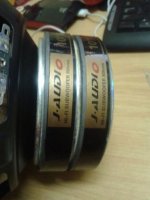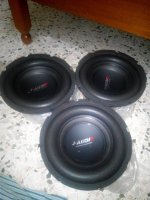Ok members, i've already found the optimal volume enclosure for this subwoofer... is about 1.2cuft tune to around 45Hz using slot port for best results ... i have a custom single box for it now.
Now the confusion comes in here ... i would like to order 3 more of them back and build a slot port box (arrange the woofers in a row) ... now i dont know to separate each volume for each of the woofers or let all 3 woofers share the same enclosure volume ... Attached below there was a photo of a completed single box for this woofer
For Best results what approach u all members will go for ... ? let the woofers have their own individual separate enclosure or let all 3 woofers share the same enclosure (no separators)? ... Help need for this design ... TQ ...
Now the confusion comes in here ... i would like to order 3 more of them back and build a slot port box (arrange the woofers in a row) ... now i dont know to separate each volume for each of the woofers or let all 3 woofers share the same enclosure volume ... Attached below there was a photo of a completed single box for this woofer
For Best results what approach u all members will go for ... ? let the woofers have their own individual separate enclosure or let all 3 woofers share the same enclosure (no separators)? ... Help need for this design ... TQ ...
Attachments
Theoretically it shouldn't make a difference. In practice, separate volumes might be best - the internal dividers will act as braces and reduce panel flex. And if one driver fails for some reason, you can still run the other two without having to make any adjustments to the box to compensate.
Ok got the difference now ... currently this custom box is Labyrinth Slot Port ... Another thing concern here is the difference between the Labyrinth Slot Port and the L-Shape slot port (as shown in the drawing below) ... which usually will hit the bass more solid and harder?
Attachments
I'd expect the L-shaped port to come away with less turbulance.
That said, your port is very small for that driver - it looks like its capable of considerable excursion, so I'd recommend going larger to avoid port compression. This would also give you more output.
If you have the T/S parameters for these drivers, we might be able to try something more exotic, like a tapped horn, which can have up to 6dB more output per driver than a bass-reflex box. The compromise is that a tapped horn will be larger.
How much power do you have?
Chris
That said, your port is very small for that driver - it looks like its capable of considerable excursion, so I'd recommend going larger to avoid port compression. This would also give you more output.
If you have the T/S parameters for these drivers, we might be able to try something more exotic, like a tapped horn, which can have up to 6dB more output per driver than a bass-reflex box. The compromise is that a tapped horn will be larger.
How much power do you have?
Chris
Each of these rated at 150Wrms (250Wpeak) ... going to get a 600Wrms Monoblock soon ... 3 units will be used in total
it looks like its capable of considerable excursion
The surround suggests as much, but the space between the spider and the magnet (if I'm interpreting the second picture correctly) suggests otherwise.
Each of these rated at 150Wrms (250Wpeak) ... going to get a 600Wrms Monoblock soon ... 3 units will be used in total
The t/s parameters are more important for box design. The important ones are as follows:
Vas = "equivalent air compliance"
Fs = resonance frequency
Qts = Total driver Q (basically its tendency to resonate at Fs)
Xmax = driver's linear excursion
Also helpful would be Sd = Driver's moving surface area
For more info, see Thiele/Small - Wikipedia, the free encyclopedia
The surround suggests as much, but the space between the spider and the magnet (if I'm interpreting the second picture correctly) suggests otherwise.
The spider is raised, by the looks of it. Either way, I'd expect, say, 10mm inward travel if the spider and motor assembly is up to it.
How usually the Sd is determined? have the formulae or something? By the looks of this driver to u all member does it suggest a small or large Sd area?
I'd expect the L-shaped port to come away with less turbulance.
That said, your port is very small for that driver - it looks like its capable of considerable excursion, so I'd recommend going larger to avoid port compression. This would also give you more output.
If you have the T/S parameters for these drivers, we might be able to try something more exotic, like a tapped horn, which can have up to 6dB more output per driver than a bass-reflex box. The compromise is that a tapped horn will be larger.
How much power do you have?
Chris
Ok regarding the L-port ... should i smooth the inside turns by including a 45degrees edge rather than a direct sharp 90 degrees bend? will improve matters here?
Yes that will help. Increasing the area near the ends of the port will also decrease port chuffing. You do this by using an angled piece of MDF for the last 5 cm.
Flares for Slot Ports
High Output Enclosures Picture Log - Page 14
Flares for Slot Ports
High Output Enclosures Picture Log - Page 14
Have you tried that driver in a sealed box?
You should be able to drop the volume to 1 cu feet and you will be able to hit deeper bass notes than your ported box. (Unless you build a bigger ported box with a very low tuning.)
You will loose some output from not having the port but because of cabin gain the volume produced might still be sufficient as is.
I have had my mind totally changed on my perception on sealed boxes in the last few months. A single 10" off a powerful amp in a sealed box can be incredibly loud and it can sound incredible while doing it.
Also remember that you will need to use sufficient high pass protection when running in a ported box.
You should be able to drop the volume to 1 cu feet and you will be able to hit deeper bass notes than your ported box. (Unless you build a bigger ported box with a very low tuning.)
You will loose some output from not having the port but because of cabin gain the volume produced might still be sufficient as is.
I have had my mind totally changed on my perception on sealed boxes in the last few months. A single 10" off a powerful amp in a sealed box can be incredibly loud and it can sound incredible while doing it.
Also remember that you will need to use sufficient high pass protection when running in a ported box.
Deep Bass is not an issue because my design target is running in concern of tight and hard bass ... i want my box to have a high peak gain around 45Hz to about 75Hz ... that is my corcern due to my interest is towards loud thumping bass and not really a fan of dubsteps ...
Deep Bass is not an issue because my design target is running in concern of tight and hard bass ... i want my box to have a high peak gain around 45Hz to about 75Hz ... that is my corcern due to my interest is towards loud thumping bass and not really a fan of dubsteps ...
I used to think exactly what you are thinking now.
About 6 months ago I installed a 10 inch pioneer in my wifes car.
Due to space limitations with having young children I stripped out the one side panel in the boot and had a fiber glass box made. I have lost only a few centimeters in the boot now because of all the dead space we managed to use.
The box is sealed. Somewhere around 1.1 cu.
I bought three second hand old school rockford amps to drive the setup.
600a2 to the sub - how its connected the amp is capable of pushing 680RMS.
200a4 - four channel bridged into two channels for mid bass in the front doors (phoenix gold 6.5")
another 200a4 - another four channel bridged into two channels which powers split that are in the foot wells. (phoenix gold elite - these drivers were made my morel. My friend gave me these awesome splits for free. They are on their own passive 24/db crossover. Yes.... a passive 24db/ocatave crossover.)
All of these amps are rated at 0.05 THD at RMS power. So as clean as a whistle.
Anyway, getting sidetracked here.
This subwoofer sounds mind blowing for anything you can throw at it.
I listen to most kinds of music. I can appreciate most things that sound good.
So I play anything from Nickelback (rock) - Trance - Katy Peary (POP) - Craig David (RNB) - House - Even some classical music sound tracks.
And everytime I drive the car I can not believe how amazing it sounds.
The bass actually just below the point of hurting my ears.
There is another thing though. Before I pollute your head with my ideas.
These pioneer subs have been designed to work incredibly well in small sealed boxes.
The sub is 350rms and judging how hard I push it, it can really take the power. The x-max is also decent at almost 13mm. To top it off it is a really efficient sub 93db at 1 watt.
I spend alot of time researching what the best 10 inch was which was efficient, could run in a small box, cost effective and can take a beating. This pioneer ticked all of those check boxes.
Amazon.com : Pioneer TS-W260D4 Champion Series 10" subwoofer with dual 4-ohm voice coils : Vehicle Subwoofers : Car Electronics
You said your sub is only 150watts and from the pictures the gap between the spider and magnet doesnt look massive so you may not have as much excursion as the surround suggests.
So you might need to use two subs to match what I am getting out of one sub.
If you do decide to go for a ported box it would be far easier to build one box with one large port. If you really want more SPL then build a very large box with one big port.
Use WinISD to model this, it is really easy to use.
My one friend years ago built his car for SPL. Was very loud - he got 150db's from two 12's but sounded pathetic when playing music.
To make it work for normal life between competitions he would fill up the port to make the box sealed.
- Status
- Not open for further replies.
- Home
- Loudspeakers
- Subwoofers
- Triple 10" subwoofer box ... share or separate






